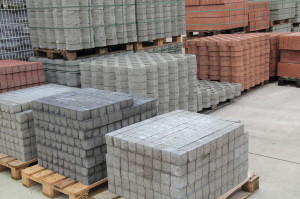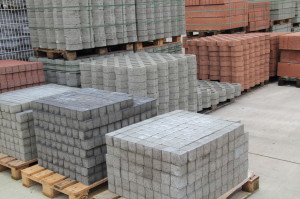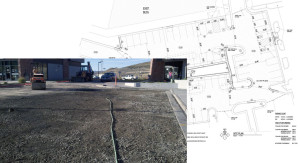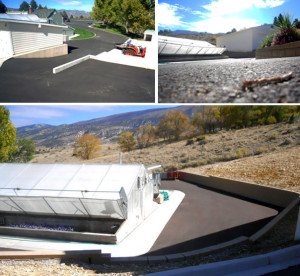The advantages and disadvantages of using precast concrete in structural engineering
 Precast concrete is a construction material used in structural engineering for several decades. It’s made by casting concrete in a reusable mold or form outside its final location. The precast concrete elements are transported to the construction site and assembled into the final structure. As we have covered in our previous blog posts, concrete is a very popular material, used in almost every structure today.
Precast concrete is a construction material used in structural engineering for several decades. It’s made by casting concrete in a reusable mold or form outside its final location. The precast concrete elements are transported to the construction site and assembled into the final structure. As we have covered in our previous blog posts, concrete is a very popular material, used in almost every structure today.
Here at McNeil Engineering, we use a lot of concrete in our projects. With precast concrete, however, there are several advantages and also some disadvantages to using it in structural engineering, which we have outlined below.
Advantages of Precast Concrete in Structural Engineering:
- Quality Control: Precast concrete elements are manufactured under controlled conditions in a factory, allowing for better quality control than on-site construction. The precast elements are produced using high-quality materials and subjected to rigorous testing, resulting in higher quality and consistency than site-cast concrete.
- Speed of Construction: Precast concrete elements can be manufactured in large quantities in a factory and transported to the construction site as needed. This results in faster construction times and a shorter project schedule. Precast concrete elements can also be installed quickly, reducing the time required for on-site assembly and minimizing disruption to the surrounding area.
- Cost-Effective: Precast concrete may have higher initial costs due to the need for molds and transportation, but it can be more cost-effective in the long run. Precast elements require less labor and equipment on-site, reducing the overall project cost. Additionally, the high-quality finish of precast concrete can eliminate the need for additional finishing work, saving time and money.
- Durability: Precast concrete is known for its durability and resistance to environmental factors, such as extreme weather conditions and chemical exposure. It is also resistant to fire and has a long service life, which can reduce the need for frequent maintenance and repairs.
- Flexibility: Precast concrete elements can be designed and manufactured to meet various structural requirements. They can be used in various building types and configurations, including multi-story buildings, bridges and retaining walls. Precast elements can also be customized to match specific design requirements for projects, allowing for greater flexibility in design.
- Reduced Site Disruption: Precast concrete elements are manufactured off-site, reducing on-site construction and disruption to the surrounding area. This can be particularly beneficial in urban or densely populated areas where minimizing disruptions is important.
- Improved Safety: Precast concrete elements are produced in a controlled factory environment, improving workers’ safety compared to on-site construction. This reduces the risk of accidents and injuries, and can also improve the quality of the final product.
Disadvantages of Precast Concrete in Structural Engineering:
- Transportation and Installation: Precast concrete elements can be heavy and require specialized equipment for transportation and installation. The size and weight of precast elements may also limit the use of certain construction methods, such as crane placement, which could result in additional costs and logistical challenges.
- Environmental Impact: The manufacturing process for precast concrete can have a significant environmental impact. Concrete production requires large amounts of energy and releases carbon dioxide into the atmosphere. Additionally, the transportation of precast elements can contribute to greenhouse gas emissions.
- Maintenance: While precast concrete is durable and requires minimal maintenance, repairs can be more complex and costly than on-site repairs to site-cast concrete. Precast elements may also require special maintenance, such as sealing joints and replacing damaged elements.
Precast concrete is popular in structural engineering due to its many advantages. The quality control, speed of construction, and cost-effectiveness of precast elements make it an attractive option for many construction projects. The durability and flexibility of precast concrete also make it a reliable and versatile building material. However, precast concrete has several disadvantages, including transportation and installation challenges, potential environmental impact and unique maintenance requirements.
When considering the use of precast concrete in structural engineering, it is important to carefully evaluate the project’s specific needs and weigh the pros and cons of this material. Precast concrete may be a good option for projects that require speed of construction, high-quality finishes and durability. However, projects that require specialized installation methods, or have strict environmental requirements may not be well-suited for precast concrete.
Additionally, it is important to work with experienced and reputable manufacturers and contractors like our engineers at McNeil Engineers when using precast concrete in structural engineering. Proper planning, design and quality control measures can help minimize the risks associated with this material and any other project materials and ensure a successful construction project.
If you’re considering a project involving precast concrete or need a structural engineer, we hope you’ll contact the team at McNeil Engineering here. You can also check out some of our previous structural engineering projects here. You can count on our professionalism, understanding of the construction process and commitment to quality design. The result is the most efficient, economical and safe structures specifically suited to your needs.








 While we are best known regionally for patented architectural engineering consultation services – which we have put to good use on thousands of projects around the American west regional area – we also have an arsenal of other consultation expertise beyond just architectural engineering too.
While we are best known regionally for patented architectural engineering consultation services – which we have put to good use on thousands of projects around the American west regional area – we also have an arsenal of other consultation expertise beyond just architectural engineering too.
 If you want to keep the exterior of your property looking architecturally healthy and durable, then it is important to maintain it on a regular basis. It does not matter what type of driveway or parking lot you have, you must take preemptive actions to protect it from harmful factors while mitigating disruptive risks.
If you want to keep the exterior of your property looking architecturally healthy and durable, then it is important to maintain it on a regular basis. It does not matter what type of driveway or parking lot you have, you must take preemptive actions to protect it from harmful factors while mitigating disruptive risks.


 Delta turned to McNeil Engineering for our skills and extensive experience in paving solutions as integral parts of a civil engineering project. As with every McNeil Engineering project, we began with consultations with the client. It’s essential to determine exactly what the client needs and expects from the project.
Delta turned to McNeil Engineering for our skills and extensive experience in paving solutions as integral parts of a civil engineering project. As with every McNeil Engineering project, we began with consultations with the client. It’s essential to determine exactly what the client needs and expects from the project. “When we first arrived on site, it was obvious that the existing parking lot was flat. While that may look good when it comes to appearances, that is not so good when you need to get water off the surface,” Green explains. “Water is the single most destructive force on the planet, and when it sits on a paved surface, it begins to slowly wear down the surface prematurely.”
“When we first arrived on site, it was obvious that the existing parking lot was flat. While that may look good when it comes to appearances, that is not so good when you need to get water off the surface,” Green explains. “Water is the single most destructive force on the planet, and when it sits on a paved surface, it begins to slowly wear down the surface prematurely.”